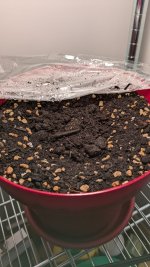Skafidr
Well-Known Member
Let's do science!
I meant to start this at least a month ago but heh... it seems I was busy with something else.
I'm wondering two things:
Setup quality
I have two sunblaster lights that I used to keep succulent plants alive during the winter a couple of years ago. I also have a shelf that I can adjust the height of each shelf so the idea is to move the lights up as the plants grow.
The hypothesis is that at some point the light will not be sufficient for the plant, given that it'll only be coming from the top. Thus, the hypothesis is that my setup is not sufficient to grow tobacco plants indoors.
Difference in planting methods
I was wondering some time ago what would be the effect of directly sowing in the final container, and Bob suggested I test both approaches: plant directly in the final pot, and use the "classic" method of planting in smaller pots and upgrading pot size as the plant grows bigger. I understand that it is not relevant in the case of normal outdoor growing, but what about just planting inside?
The hypothesis is that planting directly in the final pot will allow a faster growth because, presumably, the transfer to bigger pot disturbs the growth.
The plan
Sow in final pot
I may update the setup by adding a fan and Mylar to it, if I can.
Day 0, January 2nd 2025 (not the day I'm writing/posting this)
Setup
Note for the reader: I already have news for my next log entry which I'll create at a later time.
I meant to start this at least a month ago but heh... it seems I was busy with something else.
I'm wondering two things:
- Do my grow lights with my shelf suffice to produce a decent tobacco plant indoors ('Setup quality')?
- What is the difference between sowing the seeds directly in the final pot compared to sowing them in smaller pot, then transferring to a bigger pot, then to the final pot ('Difference in planting methods')?
Setup quality
I have two sunblaster lights that I used to keep succulent plants alive during the winter a couple of years ago. I also have a shelf that I can adjust the height of each shelf so the idea is to move the lights up as the plants grow.
The hypothesis is that at some point the light will not be sufficient for the plant, given that it'll only be coming from the top. Thus, the hypothesis is that my setup is not sufficient to grow tobacco plants indoors.
Difference in planting methods
I was wondering some time ago what would be the effect of directly sowing in the final container, and Bob suggested I test both approaches: plant directly in the final pot, and use the "classic" method of planting in smaller pots and upgrading pot size as the plant grows bigger. I understand that it is not relevant in the case of normal outdoor growing, but what about just planting inside?
The hypothesis is that planting directly in the final pot will allow a faster growth because, presumably, the transfer to bigger pot disturbs the growth.
The plan
Sow in final pot
- sow the seeds directly in the final pot
- once enough of them have grown, pluck the smallest ones
- repeat after a couple of weeks to keep only one
- take care of it until the end of the experiment
- sow the seeds in two pots
- once enough of them have grown, take a part of the roots and the soil and transfer it to a medium pot
- once it has grown enough, move the "best" plant from the medium pot to the final pot
- take care of it until the end of the experiment
I may update the setup by adding a fan and Mylar to it, if I can.
Day 0, January 2nd 2025 (not the day I'm writing/posting this)
Setup
- Final pots: ~4L in volume
- Growing medium: a ratio of 4:0.75 of garden soil from last season : pumice
- Sowing medium: MiracleGro seed starting potting mix
- Sow in final pot:
- the pot is not completely filled
- the spot where the seeds are sowed, a tiny bit of seed starting mix has been placed
- Sow in small pots:
- two pots are started, the "best" one will be moved to the final pot
- ~1½" pots as the first step, ~5" pots as the second step, the final pots as the third step
- the small pots are filled with seed starting mix
- A heat mat will rest on top of the "final pot", and the small pots will be placed on top of it; expectation: the heat mat will heat the seeds above and below
- The "small pots" are in a container with a transparent plastic cover, the "final pot" is covered by the heat mat; in both cases, it is presumed that this will suffice to keep the humidity
- Seeds: un-bagged "Turkish" (potentially crossed with Big Red Strong and Little Canadian and/or other plants from the neighbourhood which I'm unaware of) from my last season harvest
Note for the reader: I already have news for my next log entry which I'll create at a later time.
Attachments
Last edited:











